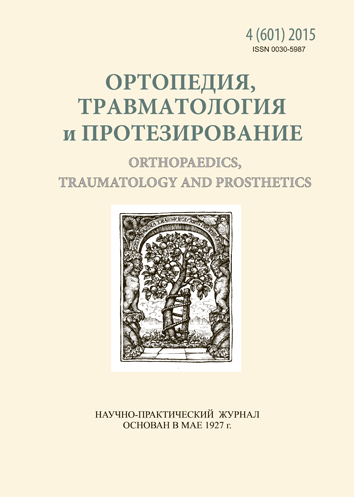Mathematic modeling of the influence of femur malalignment on the bearing of lower extremity joints
DOI:
https://doi.org/10.15674/0030-59872015425-30Keywords:
femur, deformity, malalignment, tension, modeling, lower extremityAbstract
The forming of posttraumatic deformity of long bones is accompanied with development of secondary changes in all tissues of injured segment. Theoretically the redistribution of bearing areas, osteoarthritic changes and restriction of range of motion in adjusted joints can appear. Usage of mathematical modeling allows creating 3D models of biological objects and reveals main tendencies of the changes of their stress-strain status. The goal: to work out the mathematical model of lower extremity and to study, using the model, the influence of varus extraarticular deformity of femur on stress distribution in knee, ankle and subtallar joints. Methods: mathematical models of lower extremity under normal conditions and under conditions of femur varus deformity (45°) in middle 1/3. Exertion according to Mises was a criterion to assess stress-strain status. The modeling was performed using the system of automated designing SolidWorks and calculation of stress-strain status – program complex CosmosM. Results: in knee medial condyle of femur appeared more overloaded under the conditions of femur varus malalignment and corresponding area of bearing of proximal tibia (26.9 vs 4.9 MPa under normal conditions). Double increase in strain was observed on lateral edge of knee joint (6.1 vs 3.4 Mpa). On the level of ankle joint almost triple increase in stress-strain status was observed on lateral parts of both tibia and talar. Conclusion: varus malalignment of femur provokes severe increase in tension in femur and tibia, imbalance in tension significance on medial and lateral sides of these bones with its prevalence on medial side, and severe increase in tension value on medial side of bearing areas of knee joint.References
- The role stem cells in fracture healing and nonunion / C. Y. Fayaz, C. V. Giannoudis, M. S. Vrahas [et al.] // Int. Orthop. — 2011. — Vol. 35, № 11. — P. 1586–1597, doi: 10.1007/s00264-011-1338-z.
- Popsujshapka A. The incidence of nonunion and delayed union after isolated diaphyseal fractures of femur / A. Popsujshapka, O. Uzhegova, V. Litvishko // Orthopedics, traumatology and prosthesis. — 2013. — № 1. — P. 39–43, http://dx.doi.org/10.15674/0030-59872013139-43.
- Marti R. K. Osteotomies for posttraumatic deformities / R. K. Marti, R. J. van Heerwaarden. — New York: Thiem, 2008. — 703 p.
- Chapman’s Orthopaedic Surgery / M. W. Chapman, R. M. Szabo, K. S. Vince, A. Mann. — 3d ed. — Lippincott Williams &Wilkins Publisher, 2001. — 188 p.
- Redento More. Nonunions of the long bones diagnosis and treatment with compression-distraction techniques / More Redento. — Springer-Verlag, Italia, 2006. — 279 p.
- Paley D. Principles of deformity correction / D. Paley. — 2002. — 806 p.
- Zenkevich O. Finite elements methods in technics / O. Zenkevich — M: Мир, 1978. — 519 с.
- Finite elements methods in clinical biomechanics and the forecasting of results after plastics of bone cavity with verities of calcium-phosphate ceramics /
- V. Filipenko, Z. Miteleva, Z. Zyman [and others] // Orthopedics, traumatology and prosthesis. — 2006. — № 2. — p. 34–41.
- The significance of stress distribution in bone around the components of hip endoprothesis for the stability of implant fixation / N. Korz, V. Filippenko, V. Tankut [and others] // Newsletter of SevNTU. — 2013. — № 137. — p. 110–118.
- Berezovskij V. Biophysical properties of human tissues: reference book / V. Berezovskij, N. Kolotilov. — K. Naukova dumka [Scientific thought], 1990. — 224 p.
- Alyamovskij A. SolidWorks/COSMOSWorks. Engineering analysis with finite element method / A. Alyamovskij. — М.: DMK Press, 2004. — 432 .
- Effects of increased chronic loading on articular cartilage material properties in the Lapine tibio-femoral joint / M. L. Roemhildt, K. M. Coughlin, G. D. Peura [et al.] // J. Biomechanics. — 2010. — Vol. 43, № 12. — P. 2301–308, doi: 10.1016/j.jbiomech.2010.04.035.
- Changes induced by chronic in vivo load alteration in the tibiofemoral joint of mature rabbits / M. L. Roemhildt, B. D. Beynnon, M. Gardner-Morse [et al.] // J. Orthop. Res. —2012. — Vol. 30, № 9. — Р. 1413–422, doi: 10.1002/jor.22087.
- Changes in in vitro compressive contact stress in the rat tibiofemoral joint with varus loading / M. Gardner-Morse, G. Badger, B. Beynnon, M. Roemhildt // J. Biomech. — 2013. — Vol. 46, № 6. —P. 1216–220, doi:10.1016/j.jbiomech.2013.01.009.
Downloads
How to Cite
Issue
Section
License
Copyright (c) 2015 Mykola Korzh, Konstantin Romanenko, Mykhaylo Karpinsky, Dmytro Prozorovsky, Oleksandr Yaresko

This work is licensed under a Creative Commons Attribution 4.0 International License.
The authors retain the right of authorship of their manuscript and pass the journal the right of the first publication of this article, which automatically become available from the date of publication under the terms of Creative Commons Attribution License, which allows others to freely distribute the published manuscript with mandatory linking to authors of the original research and the first publication of this one in this journal.
Authors have the right to enter into a separate supplemental agreement on the additional non-exclusive distribution of manuscript in the form in which it was published by the journal (i.e. to put work in electronic storage of an institution or publish as a part of the book) while maintaining the reference to the first publication of the manuscript in this journal.
The editorial policy of the journal allows authors and encourages manuscript accommodation online (i.e. in storage of an institution or on the personal websites) as before submission of the manuscript to the editorial office, and during its editorial processing because it contributes to productive scientific discussion and positively affects the efficiency and dynamics of the published manuscript citation (see The Effect of Open Access).














